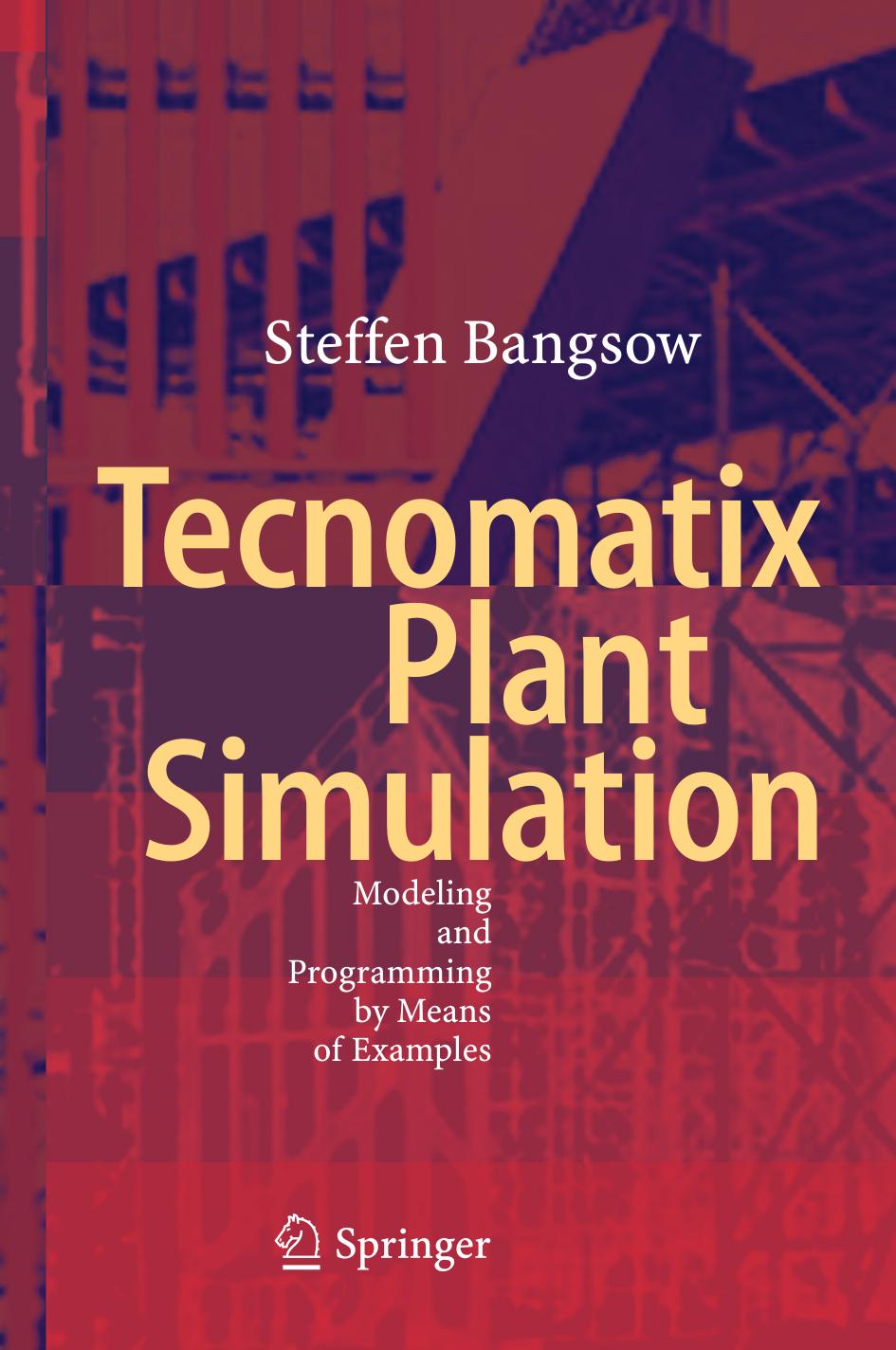Tecnomatix Plant Simulation 1st edition by Steffen Bangsow ISBN 3319195034 9783319195032
$70.00 Original price was: $70.00.$35.00Current price is: $35.00.
Instant download Tecnomatix Plant Simulation after payment
Tecnomatix Plant Simulation 1st edition by Steffen Bangsow – Ebook PDF Instant Download/Delivery: 3319195034 , 9783319195032
Full download Tecnomatix Plant Simulation 1st edition after payment

Product details:
ISBN 10: 3319195034
ISBN 13: 9783319195032
Author: Steffen Bangsow
This book systematically introduces the development of simulation models as well as the implementation and evaluation of simulation experiments with Tecnomatix Plant Simulation. It deals with all users of Plant Simulation, who have more complex tasks to handle. It also looks for an easy entry into the program. Particular attention has been paid to introduce the simulation flow language SimTalk and its use in various areas of the simulation. The author demonstrates with over 200 examples how to combine the blocks for simulation models and how to deal with SimTalk for complex control and analysis tasks. The contents of this book ranges from a description of the basic functions of the material flow blocks to demanding topics such as the realization of a database-supported warehouse control by using the SQLite interface or the exchange of data by using XML, ActiveX, COM or DDE.
Tecnomatix Plant Simulation 1st Table of contents:
PART I: INTRODUCING MATERIAL FLOW AND LOGISTICS SIMULATION
1.1 Introducing Material Flow and Logistics Simulation
1.1.1 Uses
1.1.2 Definitions
1.1.3 Procedure of Simulation
1.2 Plant Simulation: First Steps
1.2.1 The Tutorial
1.2.2 Step-by-Step Help
1.2.3 Example Collections and Demo Videos
1.2.4 The Siemens PLM Software Community
1.3 Introductory Example
1.4 First Simulation Example
1.4.1 Insert Objects into the Frame
1.4.2 Connect the Objects
1.4.3 Define the Settings of the Objects
1.4.4 Run the Simulation
1.5 Modeling
1.5.1 Object-Related Modeling
1.5.2 Object-Oriented Modeling
1.6 Student and Demo Version
PART II: SIMTALK AND DIALOGS
2.1 The Object Method
2.2 The Method Editor
2.2.1 Line Numbers, Entering Text
2.2.2 Bookmarks
2.2.3 Code Completion
2.2.4 Information about Attributes and Methods
2.2.5 Templates
2.2.6 The Debugger
2.3 SimTalk
2.3.1 Names
2.3.2 Anonymous Identifiers
2.3.3 Paths
2.3.4 Comments
2.4 Variables and Data Types
2.4.1 Variables
2.4.2 Local Variables
2.4.3 Arrays
2.4.4 Global Variables
2.5 Operators
2.5.1 Mathematical Operators
2.5.2 Logical (Relational) Operators
2.5.3 Assignments
2.6 Branching
2.7 Case Differentiation
2.8 Loops
2.8.1 Conditional Loops
2.8.2 For Loop
2.9 Methods and Functions
2.9.1 Passing Arguments
2.9.2 Passing Several Arguments at the Same Time
2.9.3 Result of a Function
2.9.4 Predefined SimTalk Functions
2.9.5 Method Call
2.10 Interrupt Methods
2.10.1 The Wait Statement
2.10.2 Suspending of Methods
2.11 Debugging, Optimization
2.11.1 Breakpoints in Methods
2.11.2 Breakpoints in the EventController
2.11.3 Error Handler
2.11.4 Profiler
2.12 Hierarchical Modeling
2.12.1 The Frame
2.12.2 The Interface
2.12.3 Create Your Own Libraries
2.13 Dynamic Model Generation
2.13.1 Required Data, SimTalk Language Elements
2.13.2 Create Objects and Set Attributes
2.13.3 Link Objects Dynamically with Connectors
2.13.4 Connect Objects Dynamically with Lines
2.14 Dialogs
2.14.1 Elements of the Dialog
2.14.2 Accessing Dialogs
2.14.3 User Interface Controls
2.14.4 Input Functions
2.14.5 Output Functions
PART III: MODELING OF PRODUCTION PROCESSES
3.1 Material Flow Library Elements
3.1.1 General Behavior of the Material Flow Elements
3.1.2 ShiftCalendar
3.2 SimTalk Attributes and Methods of the Material Flow Elements
3.2.1 States of the Material Flow Elements
3.2.2 Setup
3.2.3 Finished Messages
3.2.4 Content of the Material Flow Objects
3.3 Mobile Units (MUs)
3.3.1 Standard Methods of Mobile Units
3.3.2 Length, Width h and Booking Point
3.3.3 Entity and Container
3.4 Source and Drain
3.4.1 Basic Behavior of the Source
3.4.2 Settings of the Source
3.4.3 Source Control Using a Trigger
3.4.4 User-defined Source with SimTalk
3.4.5 The Drain
3.5 Single Processing
3.5.1 SingleProc, Fixed Chained Machines
3.5.2 Batch Processing
3.6 Simultaneous Processing of Several Parts
3.6.1 The ParallelProc
3.6.2 Machine with Parallel Processing Stations
3.6.3 Continuous Machining, Fixed Transfer Lines
3.6.4 The Cycle, Flexible Cycle Lines
3.7 Assembly Processes
3.7.1 The AssemblyStation
3.7.2 Assembly with Variable Assembly Tables
3.7.3 Use SimTalk to Model Assembly Processes
3.8 Dismantling
3.8.1 The DismantlingStation
3.8.2 Simulation of Split-Up Processes
3.8.3 Dismantle Processes Using SimTalk
3.9 Scrap and Rework
3.9.1 The FlowControl
3.9.2 Model Scrap Using the Exit Strategy
PART IV: INFORMATION FLOW AND CONTROLS
4.1 The List Editor
4.2 One-Dimensional Lists
4.2.1 The CardFile
4.2.2 StackFile and QueueFile
4.2.3 Searching in Lists
4.3 The TableFile
4.3.1 Methods and Attributes of the TableFile
4.3.2 Searching in TableFiles
4.3.3 Calculating within Tables
4.3.4 Nested Tables and Nested Lists
4.4 TimeSequence
4.4.1 The Object TimeSequence
4.4.2 TimeSequence with TableFile and SimTalk
4.5 The Trigger
4.5.1 The Object Trigger
4.5.2 Trigger with SimTalk and TableFile
4.6 The Generator
4.6.1 The Generator Object
4.6.2 User-defined Generator with SimTalk
4.7 The AttributeExplorer
4.8 The EventController
4.9 Shop Floor Control, Push Control
4.9.1 Base Model Machine
4.9.2 Elements of the Job Shop Simulation
4.10 Pull Control
4.10.1 Simple Pull Control
4.10.2 Kanban
4.10.3 The Plant Simulation Kanban Library
4.11 Line Production
4.11.1 CONWIP Control
4.11.2 Overall System Availability, Line Down Time
4.11.3 Sequence Stability
PART V: WORKING WITH RANDOM VALUES
5.1 Working with Distribution Tables
5.2 Working with Probability Distributions
5.2.1 Use of DataFit to Determine Probability Distributions
5.2.2 Use of Uniform Distributions
5.2.3 Set of Random Distributed Values Using SimTalk
5.3 Warm-Up Time
5.4 The ExperimentManager
5.4.1 Simple Experiments
5.4.2 Multi-level Experimental Design
5.5 Generic Algorithms
5.5.1 GA Sequence Tasks
5.5.2 GA Range Allocation
PART VI: SIMULATION OF TRANSPORT PROCESSES
6.1 The Line
6.1.1 Attributes of the Line
6.1.2 Curves and Corners
6.2 Angular Converter and Turntable
6.2.1 Settings of the AngularConverter
6.2.2 Settings of the Turntable
6.2.3 Turntable, Select User-defined Exit
6.3 The Turnplate
6.3.1 Basic Behavior of the Turnplate
6.3.2 Settings of the Turnplate
6.4 The Converter
6.5 The Track
6.6 Sensors on Length-Oriented Blocks
6.6.1 Function and Use of Sensors
6.6.2 Light Barrier Mode
6.6.3 Create Sensors Automatically
6.7 The Transporter
6.7.1 Attributes of the Transporter
6.7.2 Load and Unload the Transporter Using the AssemblyStation and the DismantlingStation
6.7.3 Load and Unload the Transporter Using the TransferStation
6.7.4 Load and Unload Transporter Using SimTalk
6.8 Tractor
6.8.1 General Behavior
6.8.2 Hitch Wagons to the Tractor
6.8.3 Loading and Unloading of Trains
6.9 Model Transporters with Battery
6.10 Case Studies
6.10.1 The Plant Simulation Multi-Portal Crane Object
6.10.2 Simulation of a Forklift
People also search for Tecnomatix Plant Simulation 1st :
tecnomatix plant simulation student software
tecnomatix plant simulation price
tecnomatix plant simulation vs process simulate
tecnomatix plant simulation crack
tecnomatix plant simulation tutorial
Tags: Steffen Bangsow, Tecnomatix Plant Simulation


